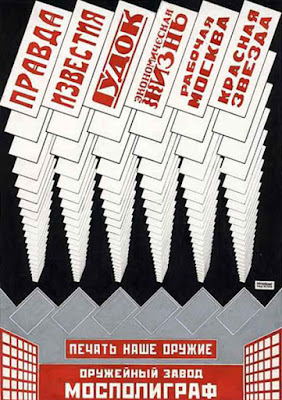Constructivism was the title of a design movement prevalent in the 1920’s in Russia. Two of its most celebrated proponents were Alexander Rodchenko and his wife Vavara Stepnova. The movement was based upon a socialist-based ideology which looked at design as a way to construct a new culture and society for the benefit of the masses.
Constructivism used advertising and commodities as mediums to promote benefits of the new socialistic and eventual communist government positions and programs. As such, most designs created by Rodchenko were advertisements for government-owned and or sanctioned products and services.
Constructivist design was more than just a style. It was design philosophy that looked at the designer, not as an individual artist concerted with self-expression, but as an engineer who constructed messages for the collective benefit of the society in which he lived.
Their design methodology was analogous to building, where the designer planned and constructed dynamically STRUCTURED compositions composed of type, images, color and graphic elements which synergized into compelling visual syntactic messages on the page.
This approach to visual communication fused with the simplistic structuring of the De Styl designers in Holland (Van Doesburg and Piet Zwart), then dynamically influenced the New Typography of Jan Tschichold in Switzerland, and visual communication design at the Bauhaus School of Design in Germany.



Constructivist Approach to STRUCTURING a Message
Historical constructivist design initially stressed the STRUCTURAL qualities of designing a message, but with its Rodchenkos success and wide-spread influence in early Soviet graphic design, it quickly became a STYLE – bold sans-serif type, the prevalent use of red and black, photography and photomontage, arrows and graphic directionals, asymmetrical and dynamic symmetrical layouts.
As Design Theory we are more concerned with the constructivist emphasis on structuralism: MESSAGE construction, composition hierarchy, and strong visual syntax than we are as its particular historic style.
Unlike the object approach to messaging, the structural design approach places its emphasis on the formal (visual and structural) aspects of an object or subject to create a message, rather than semiotics (denotation and connotation).
Both design approaches often reveal a strong concept to envision (object approach) or build (constructivist approach) a design solution.
• With the semiotic approach (object), the concept usually develops early in the design process and guides the design of final message.
• With the structural approach (constructivist), the concept usual reveals late in the design process as the designer graphically builds the message.
The Object approach to design is about the Semantic Parts of a Message, while Constructivism is more is about the Visual Structuring of the Parts into a Message.
The following images are a comparison of an historical Constructivist Poster to a contemporary Object Poster Approach Advertisement and a contemporary Constructivist Approach Poster.
Package Design
This project will be a package design for your previous object poster “object” and process poster “product.” You will design a package, with a structuralist (constructivist design) approach, to house and promote the object as a product. If needs be, you might want to need to design the product, and or “trade dress” it as well.
As a message, your package should address its sender, its function, its benefit to its audience.
Your successful package design most likely will include the following elements/content:
• A Brand
• A dominant Image
• A dominant Image
• A Product Title
• A listing of ProductFeatures
• Graphic Elements/Devices
• An implied Benefit
• Graphic Elements/Devices
• An implied Benefit
• A listing of Contents
• A set of Instructions on using the product
Project Schedule
Project Schedule
Product/Package Project Brief/Research Due Tuesday, November 14th Post on Blog
- Constructivist Design Lecture
- Package Syntax In-class Exercise
- Package Syntax In-class Exercise
Package Concept Roughs Due Thursday, November 16th Post on Blog
- Laser proof hung on crit wall
- Critique / Work in Class
Package Design Comp Due Tuesday, November 21st Post on Blog
- Laser proof comp hung on crit wall
- Critique / Work in Class
3D Package Comps/ Rendering Due Tuesday, November
28th Post on Blog
- Laser proof comp hung on crit wall
- Critique / Work in Class
Final Package Due Thursday, November 30th Post on Blog Package, Flat Layout, and/or 3D Rendering
- Final Critique














